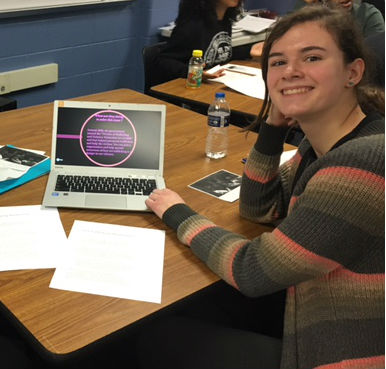In curriculum design, sometimes I feel like we are seesawing between two extremes: the kids’ need for choice in contemporary literature and teachers’ need to provide rigorous, traditional, and complex texts. This blog highlights how we attempted to find a balance.
by Karen Reed-Nordwall

Student researching women’s issues after reading I Am Malala.
Is Huck Finn relevant to this generation? Is it important to teach the canon? How do we continue to allow student choice in book selections and avoid fake reading? How do we include diverse authors and which ones? Should we include graphic novels? How do we preserve teacher choice in our curriculum?
These are a just a few of the questions that have ricocheted around my brain for the past two years during my English department’s curriculum cycle. What we teach directly affects our students. Our students aren’t stagnant–as they change their world is also changing. And so we teachers always wonder, both before we begin a unit and as we end, if we gave them what they needed. Here is a central set of questions that our department battled with this past year during our curriculum redesign:
Is it important to teach the canon, and how do we add in diverse authors?
Our answer: Yes, we agreed the canon should be taught, and we settled on 50% of the time. That ratio is what worked for our students AND teacher’s needs as content experts. The canon matters; it is relevant and complex and the foundation for English literacy. By limiting ourselves to 50% of our time, we had to make VERY difficult decisions. The other 50% of students’ time needed to be grappling with contemporary writers. We chose pieces that resonated with kids (relevant and engaging), allowed them to step in another’s shoes, and taught them about the human experience. As our students are facing a globally connected future, it was crucial to find books that represented more than just one race, economic status, gender, sexuality, and ethnicity. For engagement, students were looking for their own life experiences to be reflected back at them so they could learn about themselves and validate their own experience. We also know the power of empathy through books and wanted to make sure students were exposed to as many alternative perspectives as possible throughout their education. Furthermore, like the canon, the books we chose for our curriculum also needed to be complex text: challenging and causing students’ literacy to grow.
Ninth Grade Example
We kept 50% of the cannon and added in 50% of contemporary/diverse voices. We also still allowed students to choose their own books, but we had some whole-class reads, too. For example, in English 9, we read The Trojan Horse: The Fall of Troy, The Odyssey (excerpt), The Woman Warrior (excerpt), Romeo and Juliet, I Am Malala (YA version), Gettysburg Address, Night (excerpt), I have a Dream, and March: Book One and/or March: Book Two. Students also chose their own books, and we read short stories, blogs, articles, and poems.
Our ninth grade students loved the graphic novels we chose this year. My students loved reading about Congressman John Lewis in the March series and were interested to learn about the Freedom Rides and how many protesters were like them. They all loved the idea that young people like Malala and the Freedom Riders could make a difference in the world. I highly recommend adding in some graphic novels (March: Book One, March: Book Two, and The Trojan Horse: The Fall of Troy) and giving time to read choice books in class, even if it’s only ten minutes each day. It was the time the students most looked forward to every day.
This list is not revolutionary nor perfect, and I recognize that some schools do not have the budget to purchase new titles. This is our attempt at finding a balance, and the students appreciated the new books and chance to explore themes that interested them this year.
Karen Reed-Nordwall is an English Department Chair at Wylie E. Groves High School in Beverly Hills, MI where she currently teaches ninth and twelfth grades. She serves as a Member-at-Large for the Conference of English Leadership (CEL). You can follow her on Twitter at kr09bps.